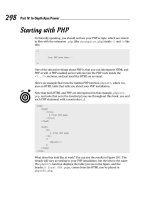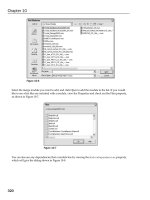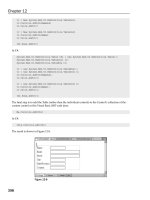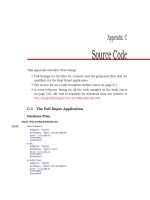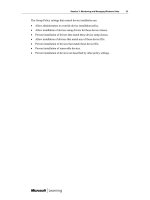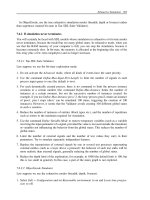Financial Toolbox For Use with MATLAB Computation Visualization Programming phần 10 doc
Bạn đang xem bản rút gọn của tài liệu. Xem và tải ngay bản đầy đủ của tài liệu tại đây (2.06 MB, 42 trang )
zbtyield
2-262
ocomp Output compounding. A scalar tha t sets the compounding frequency
per year for the output zero rates in
zr. Allowed values are:
1 = annual compounding
2 = semi-annual compounding (default)
3 = compounding three times per year
4 = quarterly compounding
6 = bimonthly compounding
12 =monthlycompounding
obasis Output day-count basis for mapping cash-flow dates to years, in
generating the output zero ra tes in
zr. A scalar.
0 = actual/actual (default), 1 = 30/360, 2 = actual/360, 3 = actual/365.
maxiter Maximum number of iterations for deriving the zero rates in zr.A
scalar. Default =
50. A value greater than 50 may slow processing.
Description [zr, cd] = zbtyield(bonds, y, sd, ocomp, obasis, maxiter) uses the
bootstrap method to return a zero curve given a portfolio of coupon bonds and
their yields. A zero curve consists of the yields to maturity for a portfolio of
theoretical zero-coupon bonds that are derived from the input
bonds portfolio.
The bootstrap method that this function uses does not require alignment
among the cash-flow dates of the bonds in the input portfolio. It uses
theoretical par bond arbitrage and yield interpolation to derive all zero rates.
For best results, use a portfolio of at least 30 bonds evenly spaced across the
investment horizon.
zr Zero rates. An M-by-1 vector of decimal fractions that are the implied zero
rates for each point along the investment horizon represented by
cd.In
aggregate, the rates in
zr constitute a zero curve.
If more th an one bond has the s ame maturity date,
zbtyield returns the
mean zero rate for that maturit y.
cd Curve dates. An M-by-1 vector of unique maturity dates (as serial date
numbers) that correspond to the zero rates in
zr. These dates begin with
the earliest maturity date and end with the latest maturity date
md in the
bonds matrix. Use datestr to convert serial date numbers to date strings.
zbtyield
2-263
Example Given data and yields to maturity for 12 coupon bonds, two with the same
maturity date; and given the common settlement date:
bonds = [datenum('6/1/1998') 0.0475 100 2 0 0;
datenum('7/1/2000') 0.06 100 2 0 0;
datenum('7/1/2000') 0.09375 100 6 1 0;
datenum('6/30/2001') 0.05125 100 1 3 1;
datenum('4/15/2002') 0.07125 100 4 1 0;
datenum('1/15/2000') 0.065 100 2 0 0;
datenum('9/1/1999') 0.08 100 3 3 0;
datenum('4/30/2001') 0.05875 100 2 0 0;
datenum('11/15/1999') 0.07125 100 2 0 0;
datenum('6/30/2000') 0.07 100 2 3 1;
datenum('7/1/2001') 0.0525 100 2 3 0;
datenum('4/30/2002') 0.07 100 2 0 0];
y = [0.048;
0.06 ;
0.089;
0.053;
0.069;
0.064;
0.078;
0.059;
0.071;
0.069;
0.057;
0.068];
sd = datenum('12/18/1997');
Set semi-annual compounding for the zero curve, on an actual/365 basis.
Derive the zero curve within 50 iterations.
ocomp = 2;
obasis = 3;
maxiter = 50;
Execute the function
[zr, cd] = zbtyield(bonds, y, sd, ocomp, obasis, maxiter)
zbtyield
2-264
whichreturnsthezerocurvezr at the maturity dates cd. Note the mean zero
rate for the two bonds with the same maturity date*.
zr =
0.0480
0.0577
0.0909
0.0529
0.0699
0.0724*
0.0584
0.0716
0.0696
0.0526
0.0687
cd =
729907
(serial d ate number for 01-Jun-1998)
730364 (01-Sep-1999)
730439 (15-Nov-1999)
730500 (15-Jan-2000 )
730667 (30-Jun-2000)
730668 (01-Jul-2000)*
730971 (30-Apr-2001)
731032 (30-Jun-2001)
731033 (01-Jul-2001)
731321 (15-Apr-2002)
731336 (30-Apr-2002)
See Also zbtprice and other functions for Term Structure of Interest Rates
References Fabozzi, Frank J. “The Structure o f Interest Rates.” Ch. 6 in Fabozzi, Frank J.
and T. Dessa Fabozzi, eds . The Handbook of Fixed Income Securities. 4th ed.
New York: Irwin Professional Publishing. 1995.
McEnally, Richard W. and James V. Jordan. “The Term Structure of Interest
Rates.” Ch. 37 in Fabozzi and Fabozzi, ibid.
Das, Satyajit. “Calculating Zero Coupon Rates.” Swap and Derivative
Financing. Appendix to Ch. 8, pp. 219-225. New York: Irwin Professional
Publishing. 1994.
zero2disc
2-265
2zero2disc
Purpose Discount curve given a zero curve.
Syntax [dr, cd] = zero2disc(zr, cd, sd, icomp, ibasis)
[dr, cd] = zero2disc(zr, cd, sd, icomp)
[dr, cd] = zero2disc(zr, cd, sd)
Arguments zr Zero rat es. An N-by-1 vector of annualized zero rates, as decimal
fractions. In aggregate, the rates in
zr constitute an implied zero
curve for the investment horizon represented by
cd.
cd Curve dates. An N-by-1 vector of maturity dates (as serial date
numbers) that correspond to the zero rates in
zr.Usedatenum to
convert date strings to serial date numbers.
sd Settlement date. A serial date number that is the common settlement
date for the zero rates in
zr; i.e., the settlement date for the bonds
from which the zero curve w as bootstrapped.
icomp Input compounding. A scalar that indicates the compounding
frequency per year used for annualizing the input zero rates in
zr.
Allowed values are:
1 = annual compounding
2 = semi-annual compounding (default)
3 = compounding three times per year
4 = quarterly compounding
6 = bimonthly co mpounding
12 = monthly compounding
365 = daily compounding
−
1 = continuous compounding
ibasis Input day-count basis used for annualizing the input zero rates in zr.
0 = actual/actual (default), 1 = 30/360, 2 = actual/360, 3 = actual/365.
Description [dr, cd] = zero2disc(zr, cd, sd, icomp, ibasis) returns a discount
curve given a zero curve and its maturity dates.
dr Discount factors. An N-by-1 vector of discount factors, as decimal
fractions. In aggregate, the factors in
dr constitute a discount curve for the
investment horizon represented by
cd.
zero2disc
2-266
cd Curve dates. An N-by-1 vector of maturity dates (as serial date numbers)
that correspond to the discount rates in
dr. This vector is the same as the
input vector
cd.Usedatestr to convert serial date numbers to date
strings.
Example Given a zero curve zr over a set of maturity dates cd, and a settlement date sd:
zr = [0.0464
0.0509
0.0524
0.0525
0.0531
0.0525
0.0530
0.0531
0.0549
0.0536];
cd = [datenum('06-Nov-1997')
datenum('11-Dec-1997')
datenum('15-Jan-1998')
datenum('05-Feb-1998')
datenum('04-Mar-1998')
datenum('02-Apr-1998')
datenum('30-Apr-1998')
datenum('25-Jun-1998')
datenum('04-Sep-1998')
datenum('12-Nov-1998')];
sd = datenum('03-Nov-1997');
The zero curve was compounded daily on an actual/365 basis.
icomp = 365;
ibasis = 3;
Execute the function:
[dr, cd] = zero2disc(zr, cd, sd, icomp, ibasis)
zero2disc
2-267
which returns the discount curve dr at the maturity dates cd:
dr =
0.9996
0.9947
0.9896
0.9866
0.9826
0.9787
0.9745
0.9665
0.9552
0.9466
cd =
729700
729735
729770
729791
729818
729847
729875
729931
730002
730071
(For readability, zr and dr are shown here only to the basis point. However,
MATLAB computed them at full precision. If you enter
zr as shown, dr may
differ due to rounding.)
See Also disc2zero and other functions for Term Structure of Interest Rates
zero2fwd
2-268
2zero2fwd
Purpose Forward curve given a zero curve.
Syntax [fr, cd] = zero2fwd(zr, cd, sd, ocomp, obasis, icomp, ibasis)
[fr, cd] = zero2fwd(zr, cd, sd, ocomp, obasis, icomp)
[fr, cd] = zero2fwd(zr, cd, sd, ocomp, obasis)
[fr, cd] = zero2fwd(zr, cd, sd, ocomp)
[fr, cd] = zero2fwd(zr, cd, sd)
Arguments zr Zero rates. An N-by-1 vector of annualized zero rates, as decimal
fractions. In aggregate, the rates in
zr constitute an implied zero
curve for the investment horizon represented by
cd.
cd Curve dates. An N-by-1 vector of maturity dates (as serial date
numbers) that correspond to the zero rates in
zr.Usedatenum to
convert date strings to serial date numbers.
sd Settlement date. A serial date number that is the common settlement
date for the zero rates i n
zr.
ocomp Output compounding. A scalar tha t sets the compounding frequency
per year for annualizing the output forward rates in
fr. Allowed
values are:
1 = annual compounding
2 = semi-annual compounding (default)
3 = compounding three times per year
4 = quarterly compounding
6 = bimonthly compounding
12 =monthlycompounding
365 = daily compounding
−
1 = continuous compounding
obasis Output day-count basis f or annualizing the forward rates in fr.
0 = actual/actual (default), 1 = 30/360, 2 = actual/360, 3 = actual/365.
icomp Input compounding. A scalar that indicates the compounding
frequency per year used for annualizing the input zero rates in
zr.
Allowed values are the same as for
ocomp. Default = ocomp.
ibasis Input day-count basis used for annualizing the input zero rates in zr.
Allowed values are the same as for
obasis. Default = obasis.
zero2fwd
2-269
Description [fr, cd] = zero2fwd(zr, cd, sd, ocomp, obasis, icomp, ibasis)
returns an implied forward rate curve given a zero curve and its maturity
dates.
fr Forward rates. An N-by-1 vector of decimal fractions. In aggregate, the
rates in
fr constitute a forward curve over the dates in cd.
cd Curve dates. An N-by-1 vector of maturity dates (as serial date numbers)
that correspond to the forward rates in
fr. This vector is the same as the
input vector
cd.Usedatestr to convert serial date numbers to date
strings.
Example Given a zero curve zr over a set of maturity dates cd, and a settlement date sd:
zr = [0.0458
0.0502
0.0518
0.0519
0.0524
0.0519
0.0523
0.0525
0.0541
0.0529];
cd = [datenum('06-Nov-1997')
datenum('11-Dec-1997')
datenum('15-Jan-1998')
datenum('05-Feb-1998')
datenum('04-Mar-1998')
datenum('02-Apr-1998')
datenum('30-Apr-1998')
datenum('25-Jun-1998')
datenum('04-Sep-1998')
datenum('12-Nov-1998')];
sd = datenum('03-Nov-1997');
zero2fwd
2-270
Set annual compounding for the forward curve, on an actual/actual basis. The
zero curve was compounded daily on an actual/365 ba sis.
ocomp = 1;
obasis = 0;
icomp = 365;
ibasis = 3;
Execute the function
[fr, cd] = zero2fwd(zr, cd, sd, ocomp, obasis, icomp, ibasis)
which returns the forward rate curve fr at the maturity dates cd:
fr =
0.0469
0.0519
0.0550
0.0536
0.0556
0.0511
0.0559
0.0546
0.0612
0.0487
cd =
729700
729735
729770
729791
729818
729847
729875
729931
730002
730071
(For readability, zr and fr are shown here only to the basis point. However,
MATLAB computed them at full precision. If you enter
zr as show n, fr may
differ due to rounding.)
See Also fwd2zero and other functions for Term Structure of Interest Rates
zero2pyld
2-271
2zero2pyld
Purpose Par yield curve given a zero curve.
Syntax [pr, cd] = zero2pyld(zr, cd, sd, ocomp, obasis, icomp, ibasis)
[pr, cd] = zero2pyld(zr, cd, sd, ocomp, obasis, icomp)
[pr, cd] = zero2pyld(zr, cd, sd, ocomp, obasis)
[pr, cd] = zero2pyld(zr, cd, sd, ocomp)
[pr, cd] = zero2pyld(zr, cd, sd)
Arguments zr Zero rat es. An N-by-1 vector of annualized zero rates, as decimal
fractions. In aggregate, the rates in
zr constitute an implied zero
curve for the investment horizon represented by
cd.
cd Curve dates. An N-by-1 vector of maturity dates (as serial date
numbers) that correspond to the zero rates in
zr.Usedatenum to
convert date strings to serial date numbers.
sd Settlement date. A serial date number that is the common settlement
date for the zero rates in
zr.
ocomp Output compounding. A scalar that sets t he compounding (coupon)
frequency per year for annualizi ng the output par yield rates in
pr.
Allowed values are:
1 = annual compounding or one payment per year
2 = semi-annual compounding (default)
3 = compounding three times per year
4 = quarterly compounding
6 = bimonthly co mpounding
12 = monthly compounding
obasis Output day-count basis for annualizing the par yield rates in pr.
0 = actual/actual (default), 1 = 30/360, 2 = actual/360, 3 = actual/365.
icomp Input compounding. A scalar that indicates the compounding
frequency per year used for annualizing the input zero rates in
zr.
Allowed values are the same as for
ocomp.Default=ocomp.
ibasis Input day-count basis used for annualizing the input zero rates in zr.
Allowed values are the same as for
obasis. Default = obasis.
zero2pyld
2-272
Description [pr, cd] = zero2pyld(zr, cd, sd, ocomp, obasis, icomp, ibasis)
returns a par yield curve given a zero curve and its maturity dates.
pr Par yield rates. An N-by-1 vector of annualized par yields, as decimal
fractions. (Par yields = coupon rates.) In aggregate, the yield rates in
pr
constitute a par yield curve for the investment horizon represented by cd.
cd Curve dates. An N-by-1 vector of maturity dates (as serial date numbers)
that correspond to the par yield rates in
pr. This vector is the same as the
input vector
cd.Usedatestr to convert serial date numbers to date
strings.
Example Given a zero curve zr over a set of maturity dates cd, and a settlement date sd:
zr = [0.0457
0.0487
0.0506
0.0507
0.0505
0.0504
0.0506
0.0516
0.0539
0.0530];
cd = [datenum('06-Nov-1997')
datenum('11-Dec-1997')
datenum('15-Jan-1998')
datenum('05-Feb-1998')
datenum('04-Mar-1998')
datenum('02-Apr-1998')
datenum('30-Apr-1998')
datenum('25-Jun-1998')
datenum('04-Sep-1998')
datenum('12-Nov-1998')];
sd = datenum('03-Nov-1997');
zero2pyld
2-273
Set annual compounding for the par yield curve, on an actual/actual basis. The
zero curve w as compounded monthly, on an actual/365 basis.
ocomp = 1;
obasis = 0;
icomp = 12;
ibasis = 3;
Execute the function
[pr, cd] = zero2pyld(zr, cd, sd, ocomp, obasis, icomp, ibasis)
which returns the par yield curve pr at the maturity dates cd:
pr =
0.0478
0.0509
0.0529
0.0529
0.0526
0.0524
0.0525
0.0534
0.0555
0.0543
cd =
729700
729735
729770
729791
729818
729847
729875
729931
730002
730071
(For readability, zr and pr are shown only to the basis point. However,
MATLAB computed them at full precision. If you enter
zr as shown, pr may
differ due to rounding.)
See Also pyld2zero and other functions for Term Structure of Interest Rates
zero2pyld
2-274
A
Glossary
A Glossary
A-2
American option - An option that can be e xercised any time until its
expiration date. Contrast with European option.
Amortization - Reduction in value of an asset over some period for accounting
purposes. Generally used with int angible assets. Depreciation is the term
used with fixed or tangible assets.
Annuity - A series of payments over a period of time. The payments are
usually in equal amounts and usually at reg ular intervals such as quarterly,
semi-annually, or annually.
Arbitrage - The purchase of securities on one market for i mmediate resale on
another market in order to profit from a p rice or currency discrepancy.
Basis point - One hundredth of one percentage point, or 0.000 1.
Beta - The price volatility of a financial instrument relative to the price
volatility of a market or index as a whole. Beta is most commonly used with
respect to equities. A high-beta instrument is riskie r (and thus usually carries
a premium price) than a low-beta instrument.
Binomial model - A method of pricing options or other equity derivatives in
which the probability over time of each possible price follows a binomial
distribution. The basic assumption is that prices can move to only two values
(one higher and one lower) over any short time period.
Black-Scholes model - The first complete mathematical model for pricing
options, developed by Fischer Black and Myron Scholes. It examines market
price, strike price, volatility, time to expiration, and interest rates. It is limited
to only certain kinds of options.
Bollinger band chart - A financial chart that plots actual asset data along
with three other bands of data: the upper band is two standard deviations
above a user-specified moving average; the lower band is two standard
deviations below that moving av erage; and th e middle band is the moving
average itself.
Bootstrapping, bootstrap method - An arithmetic method for backing an
implied zero curve out of the par yield curve.
Building a binomial tree - For a binomial option model: plotting the two
possible short-term price-changes values, and then the subsequent two values
each, and then the subsequent two values each, and so on over time, is known
as “building a binomial tree .” See Binomial mo del.
A-3
Call - a. An option to buy a certain quantity of a stock or commodity for a
specified price within a specified time. See Put.
b. A demand to submit bonds
to the issuer for redemption before the maturity date.
c. A demand for payment
of a debt.
d. A demand for payment due on stock bought o n margin when the
value has shrunk.
Callable bond - A bond that allows the issuer to buy back the bond at a
predetermined price at specified future dates. The bond contains an embedded
call option; i.e., the holder has sold a call option to the issuer. See Puttable
bond.
Candlestick chart - A financial chart usually used to plot the high, low, open,
and close price of a security over time. The body of the “candle” is the region
between the open and close price of the security. Thin vertical lines extend up
to the high and down to the low, respectively. If the open price is greater than
the close price, the body is empty. If the close price is greater than the open
price, the body is filled. See also High-low-close chart.
Cap - Interest-rate option that guarantees that the rate on a floating-rate loan
will not exceed a certain level.
Cash flow - Cash received and paid over time.
Collar - Interest-rate o ption that guarantees that the rate on a floating-rate
loan will not exceed a certain upper level nor fall below a lower level. It is
designed to protect an investor against wide fluctuations in interest rates.
Convexity - A measure of the rate of change in d uration; measured in time.
Thegreatertherateofchange,themorethedurationchangesasyieldchanges.
Correlation - The simultaneous change in v alue o f two random numeric
variables.
Correlation coefficient - A statistic in which the covariance is scaled to a
value between minus one (perfect n egative correlation) and plus o ne (perfect
positive correlation).
Coupon - Detachable certificate attached to a bond that shows the amount of
interest payable at regular intervals, usually semi-annually. Originally
coupons were actually attached to the bonds and had to be cut off or “clipped”
to redeem them and receive the interest payment.
Coupon dates - The dates when the coupons are paid. Typically a bond pays
coupons annually or semi-annually.
A Glossary
A-4
Coupon rate - The nominal interest rate that the issuer promises to pay the
buyer of a bond.
Covariance - A measure of the degree to which returns on two assets move in
tandem. A positive covariance means that asset returns move together; a
negative covariance means they vary inversely.
Delta - Therateofchangeofthepriceofaderivativesecurityrelativetothe
price of the underlying asset; i.e., the first derivative of the curv e that relates
thepriceofthederivativetothepriceoftheunderlyingsecurity.
Depreciation - Reduction in value of fixed or tangible assets over some period
for accounting purposes. See Amortization.
Derivative - A financial instrument that is based on some underlying asset.
For example , an option i s a derivativ e instrument based on the right to buy or
sell an underlying instrument.
Discount curve - The curve of discount rates vs. maturity dates for bonds.
Duration - The expected life of a fixed-income security considering its coupon
yield, interest payments, maturity, an d call features. As market interest rates
rise, the duration of a financial instrument decreases. See Macaulay duration.
Efficient frontier - A graph representing a set of portfolios that maximizes
expected return at each level of portfolio risk. See Markowitz model.
Elasticity - See Lambda.
European option - An option that can be exercised only on its expiration date.
Contrast with American option.
Exercise price - The price set for buying an asset (call) or selling an asset (put).
Thestrikeprice.
Face value - The maturity value of a security. Also known as par value,
principal value, or redemption value.
Fixed-income security - A security that pays a specified cash flow over a
specific period. Bonds are typical fixed-income securities.
Floor - Interest-rate option that guarantees that the rate on a floating-rate
loan will not fall below a certain level.
Forward curve - The curve of forward interest rates vs. maturity dates for
bonds.
A-5
Forward rate - The future interest rate of a bond inferred from the term
structure, especially from the yield curve o f zero-coupon bonds, calculated from
the growth factor of an investment in a zero held until maturity.
Future value - The val ue that a sum of money (the p resent value) earning
compound interest will have in the future.
Gamma - The rate of change of delta for a derivative security relative to the
price of the underlying asset; i.e., the second derivative of the option price
relative to the security price.
Greeks - Collectively, “greeks” refer to the financial measures d elta, gamma,
lambda, rho, t heta, and vega, which are sensitivity measures used in
evaluating derivatives.
Hedge - A securities transaction that reduces or offsets the risk on an existing
investment position.
High-low-close chart - A financial chart usually used to plot the high, low ,
open, and close price of a security over time. Plots are vertical lines whose top
is the high, bottom is the low, open is a short horizontal tick to the left, and
close is a short horizontal tick to t he right.
Implied volatility - For an option, the variance that makes a call option price
equal to the market price. Given the option price, strike price, and other
factors, the Black-Scholes model computes implied volatility.
Internal rate of return - a. The average annual yield earned b y an investment
during the period held.
b. The effective rate of interest on a loan. c. The
discount rate in discounted cash flow analysis.
d. Theratethatadjuststhe
value of future cash receipts earned by an investment so t hat interest earned
equals the original cost. See Yield to maturity.
Issuedate-The date a security is first offered for sale. That date usual ly
determines when interest payments, known as coupons, are made.
Ito process - Statistical assumptions about the behavior of security prices. For
details, see the book by Hull listed in the Bibliography.
Lambda - Thepercentagechangeinthepriceofanoptionrelativetoa1%
change in the price of the underlying security. Also known as Elasticity.
Long position - Outright ownership of a security or financial instrument. The
owner expects the price to rise in order to make a profit on some future sale.
A Glossary
A-6
Long rate - The yield on a zero-coupon Treasury bond.
Macaulay duration - A widely used measure of price sensitivity to yield
changes developed by Frederick Macaulay in 1938. It is measured in years and
is a weighted average-time-to-maturity of an instrument. The Ma caulay
duration of an income stream, such as a coupon bond, measures how long, on
average, the owner waits before receiving a payment. It is the weighted
average of the times payments are made, with the weights at time T equal to
the present value of the money received at time T.
Markowitz model - A model for selecting an optimum investment portfolio,
devised by H. M. Markowitz. It uses a discrete-time, continuous-outcome
approach for modeling i nvestment problems, often called the mean-variance
paradigm. See Efficient frontier.
Maturity date - The date when the issuer returns the final face value of a bond
to the buyer.
Mean - a. A number that typifies a set of numbers, such as a geometric mean
or an arithmetic mean.
b. The average value of a set of numbers.
Modified duration - The Macaulay duration discounted by the per-period
interest rate; i.e., divided by (1+rate/frequency). M odified duration is also
known as volatility.
Monte-Carlo simulation - A mathematical modeling process. For a model that
has several parameters with statistical properties, pick a set of random values
for the parameters and run a simulation. Then pick another set of values, and
run it again. Run it many times (often 10,000 times) and build up a statistical
distribution of outcomes of the simulation. This distribution of outcomes is
then used to answer whatever question you are asking.
Moving average - A price average that is adjusted by a dding other
parametrically determined prices over some time period.
Moving-averages chart - A financial chart that plots leading and lagging
moving averages for prices or values of an asset.
Normal (bell-shaped) distribution - In statistics, a theoretical frequency
distribution for a set of variable data, usually represented by a bell-shaped
curve symmetrical a bout the mean.
Odd first or last period - Fixed-income securities may be purchased on dates
that do not coincide with coupon or payment dates. The length of the first and
A-7
last periods may differ from the regular period between coupons, and thus the
bond owner is not entitled to the full value of the coupon for that period.
Instead, the coupon is pro-rated according to how long the bond is held during
that period.
Option - A right to buy or sell specific securities or commodities at a stated
price (exercise or strike price) within a specified time. An option is a type of
derivative.
Par value - The ma turity or face value of a security or other financial
instrument.
Par yield curve - The yield curve of bonds selling at par, or face, value.
Point and figure chart - A financial chart usually used to plot asset price data.
Upward price movements are plotted as X's and downward price movements
are plotted as O's.
Present value - Today’s value of an investment that yields some future value
when invested to earn compounded interest at a known interest rat e.; i.e., the
future value at a known period in time discounted by the interest rate over that
time period.
Principal value - See Par value.
Purchase price - Price actually paid for a security. Typically the purchase
price of a bond is not the same as the redemption value.
Put - An option to sell a stipulated amount of stock or securities within a
specified time and at a fixed exercise price. See Call.
Puttable bond - A bond that allows the holder to redeem the bond at a
predetermined price at specified future dates. The bond contains an embedded
put option; i.e., the holder has bought a put option. See Callable bond.
Quant - A quantit ati ve analyst; someone who does numerical analysis of
financial information in order to detect relati onships, disparities, or patterns
thatcanleadtomakingmoney.
Redemption value - See Par value.
Regression analysis - Statistical analysis techniques that quantify the
relationship between two or more variables. The intent is quantitative
prediction or forecasting, particularly using a small population to forecast the
behavior of a large population.
A Glossary
A-8
Rho - The rate of change in a derivative’s price relative to the underlying
security’s risk-free interest rate.
Sensitivity - The “what if” relationship between variables; the degree to which
changes in one variable cause changes in another variable. A specific synonym
is volatility.
Settlement date - The date when money first changes hands; i.e., when a buyer
actually pays for a security. It need not coincide with the issue date.
Short rate - The annualized one-period interest rate.
Short sale, short position - The sale of a security or financial instrument not
owned, in anticipation of a price decline and making a profit by p urchasing the
instrument later at a lower price, and then delivering the instrument to
complete the sale. See Long position.
Spot curve, spot yield curve - SeeZerocurve.
Spot rate - The current interest rate appropriate for discounting a cash flow of
some given maturity.
Spread - For options, a combination of call or put options on the same stock
with differing exercise prices or maturity dates.
Standard deviation - A measure of the variation in a distribution, equal to the
square root of the arithmetic mean of the squares of the deviations from the
arithmetic mean; the square r oot of the variance.
Stochastic - Involving or containing a random variable or variables; involving
chance or probability.
Straddle - A strategy used in trading options o r futures. It involves
simultaneously purchasing put and call options w ith the same exercise price
and expiration date, and it is most profitable when the price of the underlying
security is very volatile.
Strike - Exercise a put or call option.
Strike price - See Exercise price.
Swap - A contract between two parties to exchange cash flows in the future
according to some formula.
A-9
Swaption - A swap option; an option on an i nterest-rate swap. The option
gives the holder the right to enter into a contracted interest-rate swap at a
specified future date. See Swap.
Term structure - The relationship between the yields on fixed-interest
securities and their maturity dates. Expectation of changes in interest rates
affects term structure, as do liquidity preferences and hedging pressure. A
yield curve is one representation in the term struct ure.
Theta - The rate of change in the price of a derivative security relative to time.
Theta is usually very small or negative since the value of an option tends to
drop as it approaches maturity.
Treasury bill - Short-term U.S. government security issued at a discount from
thefacevalueandpayingthefacevalueatmaturity.
Treasury bond - Long-term debt obligation of the U.S. government that makes
coupon payments semi-annually and is sold at or near par value in $1000
denominations or higher. Face value is paid at maturity.
Variance - The dispersion of a variable. The square of the standard deviation.
Vega - The rate of change in the price of a derivative security relative to the
volatility of the underlying security. When vega is large the security is
sensitive to small changes in volatility.
Volatility - a. Another general term for sensitivity. b. Another term for the
specific sensitivity measure called modified duration.
c. The standard
deviation of the annualized continuously compounded rate of return of an
asset.
Yield - a. Measure of return on an investment, stated as a percentage of price.
Yield can be computed by dividing return by purchase price, current market
value, or other measure of value.
b. Incom e from a bond expressed as an
annualized percentage rate.
c. The nominal annual interest rate that gives a
future value of the purchase price equal to the redemption value of the security.
Any coupon payments determine part of that yield.
Yield curve - Graph of yields (vertical axis) of a particular type of security
versus the time to maturity (horizontal axis). This curve usually slopes
upward, indicating that investors usually expect t o receive a premium for
securities that have a longer time to maturity. The benchmark yield curve is
for U.S. Treasury securities with maturities ranging from t hree months to 30
years. See Term structure.
A Glossary
A-10
Yield to maturity - A measure of the average rate of return that will be earned
on a bond if held to maturity.
Zero curve, zero-coupon yield curve - A yield curve for zero-coupon bonds;
zero rates versus maturity dates. Since the maturity and duration (Macaulay
duration) are identical for zeros, the zero curve is a pure depiction of supply/
demand conditions for loanable funds across a continuum of durations and
maturities. Also known as spot curve or spot yield curve.
Zero-coupon bond, or Zero - Abondthat,insteadofcarryingacoupon,issold
at a discount from its face value, pays no interest during its life, and pays the
principal only at maturity.
B
Bibliography
BondPricingandYields B-2
TermStructureofInterestRates B-2
DerivativesPricingandYields B-2
PortfolioAnalysis B-3
OtherReferences B-3
B Bibliography
B-2
For the well-known algorithms and formulas used in the Financial Toolbox
(such as how to compute a loan payment given principal, interest rate, and
length of the loan), no references are given here. The references here pertain
to less common formulas.
The Reference chapter and t he online help for each function also cite specific
references when appropriate.
Bond Pricing and Yields
The pricing and yield formulas for f ix ed -income securitie s come from:
Mayle, Jan. Standard Securities Calculation Methods. New Yor k: Securities
Industry Asso ciation, Inc. Vol. 1, 3rd e d., 19 93, ISBN 1-882936-01-9. Vol. 2,
1994, ISBN 1- 882936-02-7.
In many cases these formulas compute the price of a security given yield, d ates,
rates, and other data. These formulas are nonlinear, however; so when solving
for an independent varia ble wit hin a formula, t he Financial Toolbox uses
Newton’s method. See any e lementary numerical methods textbook for the
mathematics underlying Newton’s method.
Term Structure of Interest Rates
The formulas and methodology for term structure functions come from:
Fabozzi, Frank J. “The Structure of Interest Rat es.” Ch. 6 in Fabozzi, Frank J.
andT.DessaFabozzi,eds. The Handbook of Fixed Income Securities. 4th ed.
New York: Irwin Professional Publishing. 1995. ISBN 0-7863-0001-9.
McEnally, Richard W. and James V. Jordan. “The Term Structure of Interest
Rates.” Ch. 37 in Fabozzi and Fabozzi, ibid.
Das, Satyajit. “Calculating Zero Coupon Rates.” Swap and Derivative
Financing. Appendix to Ch. 8, pp. 219-225. New York: Irwin Professional
Publishing. 1994. ISBN 1-55738-542-4.
Derivatives Pricing and Yields
The pricing and yield formula s for deriv ative securities come from:
Hull, John, C. Options, Futures, and Other Derivative Securities. Englewood
Cliffs, NJ: Prent ice- Hall. 2nd ed., 1993, ISBN 0- 13-639014-5.

